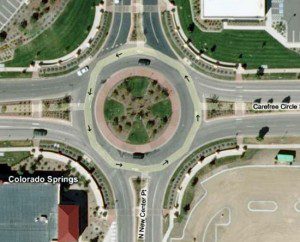
Last summer, I made an interesting discovery. Not surprising, since I was conducting research. But what I found wasn’t quite what I expected. Although it was actually quite close to home. I happened to be researching in Colorado Springs, Colorado, where, I discovered, they’ve been experimenting with something relatively new in their part of the world. What’s more, they’ve made a YouTube video about it.
“All about roundabouts,” the video says. “Getting in and getting out…”
And I thought, “Do we ever need this back home!”
“Why?” you might ask.
Well, not too long after traffic began flowing through my hometown of Uxbridge’s first ever roundabout – at Brock Street West and the 6th Concession – I started into the intersection from the west. I slowed to make sure nobody was entering ahead of me southbound from the left and began moving through intending to continue eastbound into town.
Suddenly, from the right, a driver in an SUV catapulted into the intersection. Realizing – since I was already moving through the intersection – that I had the right of way, the driver slammed on the brakes. I did too and there was no collision. But clearly, the SUV driver didn’t know the rules for using roundabouts.
It’s not that they’re new. They’re just new here.
For the record, the British built the first roundabout in 1903 in a place called Letchworth Garden City; the city intended the island in the centre of the traffic circle as a safe spot for pedestrians attempting to get through the intersection. The famous Columbus Circle roundabout opened in New York City the next year and soon after several circles in Washington, D.C.
By 1907 another famous roundabout had been built at Place de l’Etoile – that’s the one that encircles Arc de Triomphe in Paris. It’s about half a dozen lanes from the outside of the roundabout to the arch itself and take my word for it (if you’re never seen it) it’s a battle to get through. I think there are Parisians who may well have entered that roundabout in 1907, and are there yet.
But let me go back to the Colorado Springs YouTube for some of the roundabout rules we can use. According to the video:
“Know which direction you want to go, before you enter the roundabout – left turn, right turn or proceed straight. As you approach a roundabout, plan ahead and slow down.”
This is the secret to the roundabout’s success – the slow down part. Why? Well, in the first place, slower traffic increases driver reaction time. It gives all vehicles in the circulation an equal chance to advance in their chosen direction without necessarily having to stop. They also say it reduces fuel consumption (and consequently air pollution, I guess). But back to the way to drive through a roundabout:
“When entering a roundabout, you must yield to all vehicles already within the roundabout. Then follow the same rules in a roundabout that you would in a conventional intersection.”
It comes down to this: Plan ahead. Slow down. Yield. And don’t do anything in a roundabout you wouldn’t do in a regular crossroad.
Recently, roundabouts have become very popular in North America. They’re cheaper than traffic lights. They calm or slow down the traffic. And they clear traffic volume more efficiently and safely than advanced greens or dedicated lights. There are plenty of roundabouts in western Canada – especially on the Prairies. There’s a bunch in south Durham Region now. They’ve had at least one in Port Perry for several years now. As of 2009, Colorado Springs had 68 of them, with 10 more planned.
By the way, if I thought meeting an uninitiated SUV driver in the middle of our roundabout was dangerous, I recently learned about one in the U.K. that nearly proved deadly. I happened to be interviewing a veteran who talked about being a motorcycle dispatch rider in England during the last war. It was about 1944 – when just about every metre of roadway had military vehicles on it – and he said he was leading a convoy of tanks down to the English Channel for the crossing. He reached a roundabout, parked his cycle in the island and began directing the column of tanks coming up behind him. The first tank barely jogged to miss him, but came barrelling straight across the centre of the roundabout instantly crushing his motorcycle. The rest of the tank column followed, disintegrating whatever was left of his bike.
“I thought these things were safe spots on the road,” the vet said. “Not in Britain… and certainly not in wartime.”
Maybe the first rule of using a roundabout should read: “Imagine you’re in a war zone and every vehicle in the traffic circle has the potential to crush you and your vehicle.”
That might get people to stop and learn roundabout rules.